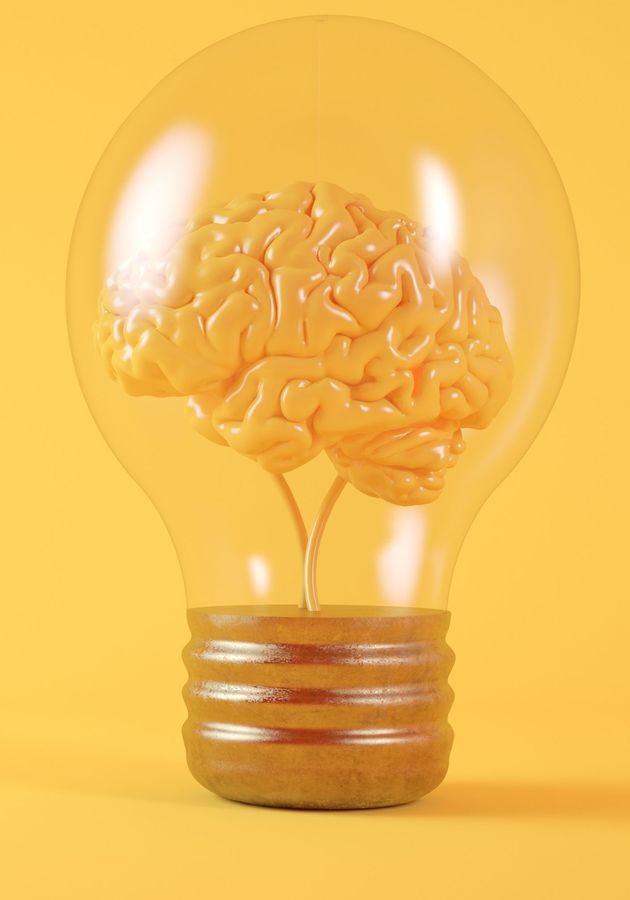Although learning starts in preschool, it isn't until one enters early teen years that they have to take notes, read textbooks, complete assignments, and study for tests. To complete these tasks successfully, students need to know how to set priorities and plan their time, read and memorize complex content, avoid procrastination, deal with the anxiety that may disrupt their learning, and many more. However, these skills are not acquired at an early age, and most likely, no one ever teaches students how to become independent learners, even though the nature of the tasks they need to do expects them to be. ‘’Outsmart Your Brain’’ by Daniel T. Willingham aims to give students of all ages what they are deprived of through education - tips on using their learning potential most efficiently. So, get ready to learn how to learn!
Learning is outsmarting the brain
Learning is a complex process, and its success does not only depend on your memorization strategies but also on how you understand lectures and book chapters, take notes, cope with exam stress, and so on. Also, much is counterintuitive about learning - for instance, the wish to learn something does not impact learning as much as you would expect. You often remember things you didn’t try to, right? You probably know who was the lead in the Forrest Gump movie or whether Prince Harry is married, only because you were exposed to these facts, and not because you made an effort to memorize them. Another weird thing about learning is that repetition may be helpful, but it does not guarantee that you will learn something. Here is a simple test - do you know what’s written across the top of a dollar bill? There’s an eagle on the back of the bill; what appears over its head? You probably do not know despite seeing a dollar bill hundreds of times.
If you want to learn something successfully, be aware that the bigger challenge will bring more benefits in the long run. Let’s say you want to increase the number of push-ups you can do. You could practice push-ups, but it would be even better if you did the difficult ones where you launch yourself on the floor and clap. At first, this may seem counterproductive since you cannot do many of them. However, it will increase your strength after some time since the challenge is greater. If you practice push-ups on your knees, it will feel like things are going great because you can do many of them quickly, but it’s certainly less beneficial. ‘’When you’re trying to learn, your brain tells you to do the mental equivalent of push-ups on your knees,’’ Willingham writes. In other words, your brain encourages you to do things that feel easy and appear as they lead to success. For this reason, becoming successful at learning means outsmarting your brain and doing the mental exercise that feels harder but ultimately brings more benefits.
How to understand a lecture
Problems in learning often arise due to students' inability to understand the lecture. You may ask now why the lack of understanding might be an issue - if you misunderstand something, you ask a question. Well, things are not that simple. What if you don’t realize that you failed to understand something?
When people talk, they present ideas linearly, one after another. However, lectures are organized differently - hierarchically - and instructors want the students to connect some ideas even when they are not next to each other like in a speech. If they miss the connection, they will miss the layer of meaning and, therefore, fail to get the overriding theme of the lecture. Say you are attending a lecture on cooking meat in a food science class, and the three main topics are cooking meat kills bacteria, impacts flavor, and makes the meat more tender. The lecturer won’t talk about these topics one after another. Moreover, they won’t necessarily highlight that killing bacteria, improving the flavor and tenderness are the main reasons why people cook meat, which is a key point of the lecture.
So, what can you do to ensure you get not only facts but deeper meaning in a lecture? First, aim at getting the top-level question or the overall theme. Written documents you get before the lecture, such as the syllabus and handouts, may help you do this. If they don’t have any notes from the lecturer, carefully listen to their introduction - it usually includes a few sentences on the overall theme. Next, try to understand how what is said relates to it. Let’s say the topic is ‘’Why do people cook meat,’’ and you hear the idea about tenderness - your task would be to think how these two correlate. Should you fail to see the connection, ask for clarification without hesitation. If you don’t like to ask questions, Willingham advises you not to regard that as an unchangeable part of your personality but as a skill like any other and one you need to work to improve.
Taking good notes
According to research, listeners capture only between 25% to 50% of points the lecturer thinks are worth writing down, and this figure doesn’t change much from middle school through college. These numbers are not surprising - taking good notes is challenging since it encompasses a series of complex tasks - understanding what the instructors say, evaluating the importance of ideas, paraphrasing, and writing them down almost as quickly as the words are spoken. As Willingham says, ‘’taking notes while listening is sort of like playing chess, watching a mystery movie, and cooking a stir-fry all at once.’’
When you take notes, your brain, desperate to keep up with the speaker, will devote more and more attention to writing quickly at the expense of trying to understand the meaning of the lecture. To outsmart it, ‘’be strategic about balancing your attention to writing and your attention to understanding.’’ That is, depending on the contents of the lecture and your learning goals, decide how much you should spend on understanding versus note-taking. In case you need to get a lot of exact information, such as details on how to perform the experiment in a physics lab section, don’t waste time on understanding the content, but on writing down as much as possible. However, if a teacher tells the class, for instance, one will earn extra credits if they can tell three key things they have learned from the lecture on the Great Migration, you should direct your mental energy to listening, understanding, and evaluating the importance of what is said.
Since note-taking requires completing multiple tasks, time is one of the main obstacles to taking good notes. Therefore, save it by preparing for the lecture beforehand - bring a pen and two spares, and make sure you charge your laptop if you use it. Don’t bring highlighters or sticky notes to the lecture - deciding when to use which color wastes your precious time without making your notes more useful. Also, evaluate your writing on the spot so you can ask the lecturer about the details you didn’t catch or understand. Next, bear in mind that ‘’the future you’’ will be reading what you wrote, and therefore, evaluate after class whether your notes will make sense to you later.
Reading difficult books
Most textbooks are hard to read because their material is dense, contains lots of information, and is, oftentimes, boring. Moreover, much like in lectures, ideas in textbooks are presented hierarchically, so readers often need to connect what they’re reading now to something they read a few pages ago. Since we first get used to reading stories with linear compositions, when reading textbooks, our brains will make us read the way we read for pleasure, without much effort to coordinate ideas. That is why you need to use specialized strategies depending on the reading material and the goals you have for reading it.
One of the most common tactics people use when reading to learn is highlighting what strikes them as essential to memorize. Highlighting is ineffective simply because it doesn’t help people connect ideas across sentences and paragraphs. Furthermore, it cannot guarantee that your judgment about what is important is good after reading the text for the first time. Don’t get us wrong, highlighting can be helpful, but only if you are reading about the topic you are familiar with or for the second or third time.
Instead of just reading or reading and highlighting, try a proven effective reading strategy called SQ3R, which is an acronym for:
- Survey. Before you start reading, try to get a rough idea of what the text is about by looking at headings, subheadings, and figures.
- Question. After you complete the survey, pose questions that you expect the text to answer.
- Read. This is when you actually read and look for information that may answer the questions from the previous stage.
- Recite. Recite what you’ve learned after each section as if you were describing it to someone else. Try to include the answers you were looking for in your presentation.
- Review. This is an ongoing process in which you revisit the content, focusing on the questions you posed and their answers.
Finally, apart from following SQ3R, take notes while you read. It will disable you from switching to casual reading, and, of course, the notes will help you refresh your memory later.
Defeat procrastination
For people who are scared of going to the dentist, it is easy to book an appointment for a checkup if it is far in the future, let’s say six months. However, if you ask them to do a checkup immediately, they would probably refuse to.
Although challenging to avoid, the psychology behind procrastination is not complicated. As Willingham says, ‘’We procrastinate to make ourselves feel better.’’ In other words, we put off an unpleasant activity in favor of a pleasant one. That is why you would play a video game first, rather than doing a math problem set or choose to do a dentist checkup in the future rather than now. Here an impulse, your brain’s response to immediate desires, plays a role. If you can control it, which means making undesirable tasks more favorable compared to tempting alternatives, you can outsmart your brain and reduce the chances you will act on impulse.
One way to defeat procrastination is by making your work habitual. Habit is an action you repeatedly do without experimenting and thinking much about it. For instance, when you get up in the morning, you don’t consider whether there are more efficient ways to make coffee - you just make it. When you brush your teeth, you don’t experiment with doing it with a nondominant hand. And perhaps more importantly, habitual actions don’t require you to think about starting them. In other words, ‘’you don’t procrastinate doing routine actions because there’s no act of choosing.’’
So, to develop the habit of working, start by finding something that will trigger your mental action plan and tell you to do it now. For high school students, cues might be finishing after-school snacks or cleaning the kitchen after supper. The key is to find something you do every day. Next, break overwhelming tasks into smaller, achievable ones, because procrastination will then be less tempting. If you struggle to avoid doing pleasant activities, such as playing video games or checking social media, make them a reward for the work you completed. Finally, tell others about your goals - they may provide you with emotional support and practical help in your effort to procrastinate less.
Final Notes
Much like a map that ensures the arrival at the destination, ‘’Outsmart Your Brain’’ is a guide that provides everything you need to acquire skills and knowledge that will make you come where your instructor wants you to be. It is a book that should be a necessary read both for students, no matter the age, as well as teachers or anyone involved in gaining or sharing knowledge of some kind. All in all, an illuminating and inspiring read!
12min Tip
Do you often struggle with procrastination? Why don’t you try defeating it using the tips Willingham provided - they can be applied to complete any task, not only those connected with learning.





























